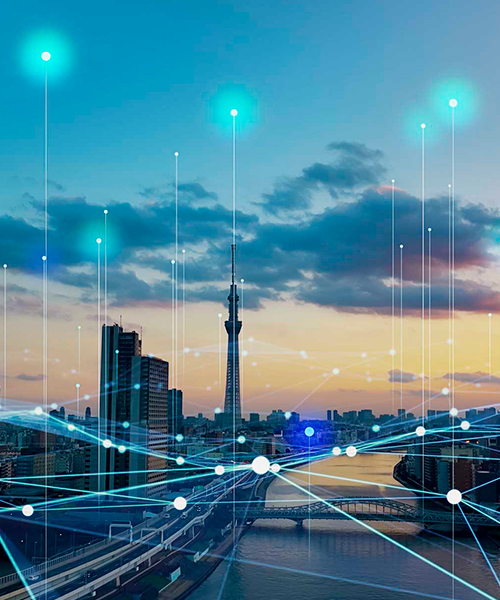
All about the Internet of Things
Technology. Innovation. Quality of life
Virtual reality
Explore beyond reality
When we speak about Virtual Reality (VR), we often associate it with entertainment or the famous metaverse. However, this technology is becoming a fundamental tool in the Fourth Industrial Revolution, driven by Artificial Intelligence (AI).
Imagine being able to travel to any part of the world without leaving home, explore the inside of the human body, or even train to be an airplane pilot from the comfort of your living room. This disruptive technology has multiple applications in a wide variety of sectors, from education and training to energy, medicine, or architecture.


What is virtual reality?
Virtual reality is a technology that allows us to create simulated environments that users can experience as if they were real. They are generated by computers and displayed through special devices, such as virtual reality headsets or goggles.
Differences between virtual and augmented reality
Virtual reality (VR) and augmented reality (AR) are two technologies that are often confused with each other. However, there are differences.
Virtual reality:
Augmented reality:
In short, virtual reality provides a fully immersive experience in a digital environment, while augmented reality enriches the real world with additional information and digital elements.

Advantages of virtual reality
It facilitates the experience of situations and sensations as if we were inside them. It allows you to travel anywhere in the world, explore the bottom of the ocean, or even live space adventures.
It enables the creation of simulated environments to train professionals in risky situations, such as pilots, firefighters, or medical personnel, without jeopardizing their safety.
Virtual reality has become an invaluable educational tool, since it allows students to learn in a more interactive and experiential way, from visiting historical sites to conducting scientific experiments.
It is used in therapies to treat phobias, trauma, anxiety disorders, and chronic pain, offering patients a safe and controlled environment to face their challenges.
It has revolutionized the entertainment industry, with video games, movies, and 360º experiences that immerse us in fantastic worlds and transport us to other realities.
It is used in the business environment to improve collaboration, communication, and employee training, resulting in increased productivity and efficiency.
It is used to create more engaging and personalized user experiences in a variety of industries, such as tourism, marketing, and retail.
It facilitates collaboration on projects and tasks remotely, allowing people to work as if they were in the same physical space, breaking down geographical barriers and improving the efficiency of teamwork.
It enables the creation of increasingly realistic simulations that are used in various fields, such as architecture, engineering, and design, to visualize and test prototypes more accurately and efficiently.
Join our team!
Launch your career and help us to create the future of energy.
Repsol and virtual reality
At Repsol, we understand that innovation is essential to remain at the forefront of the energy sector. That's why, at our Technology Lab, our research and development center, we continuously work to develop more efficient and sustainable technologies, contributing to the reduction of the carbon footprint.
Among our most innovative projects in the field of virtual reality, the following stand out: